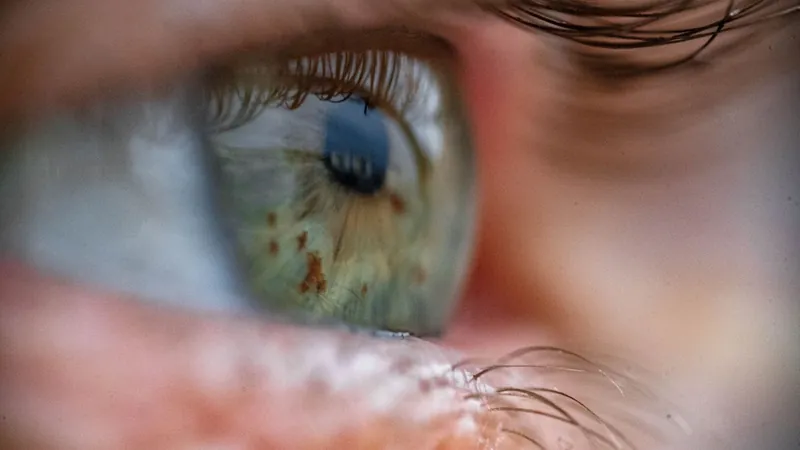
Breakthrough in Eye Research: New Cells Discovered That Could Restore Vision!
2025-03-27
Author: Nur
Groundbreaking Discovery in Eye Research
In a groundbreaking discovery that could revolutionize the treatment of vision loss, scientists have uncovered previously unidentified cells in the human eye. These cells, located in the retina—the vital light-sensitive structure at the back of the eye—may hold the key to reversing vision loss caused by prevalent diseases such as macular degeneration.
Research Methodology
The remarkable findings emerged from research utilizing donated fetal tissue samples, where the team identified and characterized these novel cells. Furthermore, they successfully replicated the cells in lab-grown models of the human retina. In an impressive breakthrough, when these models were transplanted into mice suffering from a common eye disorder, the intervention restored the rodents’ vision.
Implications of the Research
"This research not only enhances our comprehension of retinal biology but also presents immense potential for future therapies targeting retinal degeneration diseases,” the researchers noted in their detailed publication, released on March 26 in the journal *Science Translational Medicine*.
The Role of Retina in Vision
The retina is crucial for vision as it captures light and converts it into signals that the brain interprets as visual images. Unfortunately, deterioration of the retina is a leading cause of blindness globally, often spurred by factors like aging, diabetes, and physical injuries. Conditions such as macular degeneration and retinitis pigmentosa are common outcomes of this degeneration.
Current Treatment Limitations
Current treatments largely aim to slow down the deterioration of retinal cells and preserve healthy surrounding cells. However, effective therapies that can actually repair the retina and reverse damage are sadly lacking. Stem cell therapy presents a hopeful avenue, as stem cells can differentiate into various cell types, yet suitable candidates for this purpose in human retinas had been elusive before this study.
Types of Stem Cells Identified
The researchers focused on analyzing the activity of cells in the fetal retinal samples and made a significant finding—two types of retinal stem cells exhibiting promising regenerative potential: human neural retinal stem-like cells (hNRSCs) and retinal pigment epithelium (RPE) stem-like cells. Both cell types, found at the outer edge of the retina, demonstrated the ability to self-replicate, but only hNRSCs can differentiate into other retinal cell types under appropriate conditions.
3D Tissue Models and Organoids
In another critical aspect of the research, the scientists created 3D tissue models, known as organoids, to better replicate the complex structures of human organs compared to traditional models. Within these organoids, they identified the same hNRSCs as in the fetal tissue samples, along with specific molecular mechanisms that guided the transformation of these stem cells into functional retinal cells and supported repair processes.
Successful Transplantation in Mice
When the hNRSCs from these organoids were transplanted into the retinas of mice with conditions akin to retinitis pigmentosa, they successfully differentiated into the necessary retinal cells that detect and process light signals. Remarkably, this led to improved vision in the treated mice compared to those that did not receive transplants—an effect sustained throughout the 24-week duration of the experiment.
Future of Eye Health
The implications of these findings are profound; hNRSCs could pave the way for new therapeutic strategies for retinal disorders in humans. However, researchers stress that further investigations are essential to validate these promising results and fully explore the potential of these stem cells in restoring human vision. As hope grows for millions affected by retinal diseases, this discovery adds a sparkling ray of optimism in the realm of eye health.
Stay Tuned
Stay tuned for more updates on this developing story!


 Brasil (PT)
Brasil (PT)
 Canada (EN)
Canada (EN)
 Chile (ES)
Chile (ES)
 Česko (CS)
Česko (CS)
 대한민국 (KO)
대한민국 (KO)
 España (ES)
España (ES)
 France (FR)
France (FR)
 Hong Kong (EN)
Hong Kong (EN)
 Italia (IT)
Italia (IT)
 日本 (JA)
日本 (JA)
 Magyarország (HU)
Magyarország (HU)
 Norge (NO)
Norge (NO)
 Polska (PL)
Polska (PL)
 Schweiz (DE)
Schweiz (DE)
 Singapore (EN)
Singapore (EN)
 Sverige (SV)
Sverige (SV)
 Suomi (FI)
Suomi (FI)
 Türkiye (TR)
Türkiye (TR)
 الإمارات العربية المتحدة (AR)
الإمارات العربية المتحدة (AR)